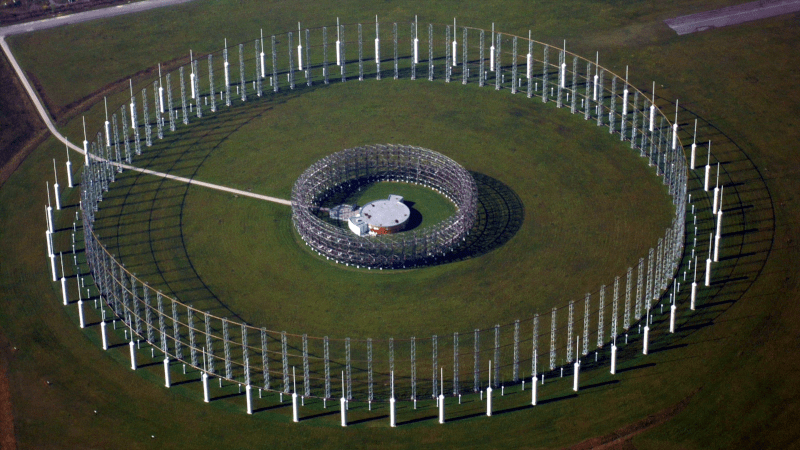With a UHF antenna, it is easy to rotate a directional antenna to find the bearing to a transmitter. But at HF, it is more common to use an array of antennas that you can electrically switch as well as analyze the phase information between the elements. [Ringway Manchester] has a look at the “elephant cage” antenna used by the US Iron Horse listening network from the 1950s. You can see a video about the giant antenna system, the AN/FLR-9.
Technically, the ring of concentric antenna elements forms a Wullenweber antenna. The whole thing consists of three rings built on a ground screen nearly 1,500 feet across. The outer ring covers from 1.5 to 6 MHz or band A. The band B ring in the center covers 6 to 18 MHz. The inner ring covers band C which was from 18 to 30 MHz. Band A was made up of 48 monopoles while band B used 96 elements. The much smaller band C elements were 48 pairs of horizontally polarized dipoles.
These listening posts could, together, locate an HF signal up to 4,000 nautical miles away. The Wullenweber design, as you may have guessed from the name, originated with the German navy during World War II. It found use in several other systems, although they are relatively rare today, with all of the AN/FLR-9 sites gone.
Cold war hardware is always interesting even if sometimes terrifying. If you think a giant shortwave direction finder is high-tech, you should check out how the Russians bugged IBM Selectric typewriters for a long time undetected.
















Not sure if I missed something but:
1.5 to 6 MHz is band A.
6 to 18 MHz is band B.
18 to 10 MHz is band C.
The way it’s written, it seems like band B and C overlaps by a lot?
Band c goes to 30MHz… Typo
Canada still operates two of these. They’re on band, eh?
Yea, I actually do the maintenance on one of them. They are sketchy as shit to work on. Things are a god damn death trap.
HG?
It’s a typo, C is 18 to 30 Mhz
What’s 1500 feet in Libraries of Congress?
Feet should only be converted to bananas. It’s 2568.539 bananas according to bananaforscale.info.
I’d be happy with a conversion to Olympic-sized swimming pools. Or halves of a giraffe.
Banana is for lengths, football field is for areas, swimming-pool is for volumes.
And Fahrenheiht for temperatures…;)
The correct unit for lengths on the scale of a bridge is smoots. 1500 feet is about 270 smoots.
https://en.wikipedia.org/wiki/Smoot
Always remember…
F is for how a temperature Feels
C is for how a Chemical reacts
K is for temperatures that will Kill you.
How many washing machines is that?
No. In nanobananas only.
How many (American) football fields is that?
/usr/bin/units
Where I was stationed in Germany we called ours the giant erector set.
I was stationed at Scaggs Island in northern San Francisco Bay for 2 years working in one of these. U.S.Navy 1967-69 Ham station there was W6KMW I’m N4NSS
Was there any down time where you could hook up your rig and transmit on it?
We had one of these on Elmendorf AFB when I was stationed there back in the 1980’s. I believe it’s still there..
It was still there in 2016.
I’ve jus looked on Google earth & it’s still there!
When I was in college at the University of Illinois, we drove around in the country a lot and we ran across one of these. I don’t remember if the antennas where still there in the early 1990’s or not. I never really looked into it at the time. The site is still there and marked as a museum on Google maps… 40.04963, -88.38067. You can find info by googling “University of Illinois wullenwebber array”. Cool history.
Unfortunately this antenna (south of Bondville) was removed in the late 90s.
Should really say ‘old cold war’ or ‘previous cold war’.
Anyway, seems you can do all your spy stuff on HF since it’s not monitored now :)
Unless… do they have elephant cages in space now? Or how do they do it now?
You wait for them to post on social media
So this is what Stonehenge was really for…
Obviously. The heavy stones because gravity waves — what kind of primitives use radio?
Direction finding at HF and lower frequencies can be done at a smaller scale with a loop antenna, which can be handheld sized, similar to UHF direction finding. The loop antenna would have a variable capacitor in parallel to tune it to the desired frequency. This setup would be limited to monitoring one frequency at a time.
AM radios with loop antennas were used to listen to stations that the Germans were trying to jam during WWII, making use of the antenna’s directionality.
Had these in the Navy also. One at Naval Communications Station – Nea Makri, Greece. Was Crypto tech there 1971/72. Base was closed in 1975, I think. Wullenweber was dismantled, base turned over to Greek government. It is a training facility for firefighters now, pixellated for some reason on Google Earth.
I wonder if a car driving down that road might interfere and what that would sound like
Visited one in grade school 55 yrs ago. Probably one reason I became a ham.